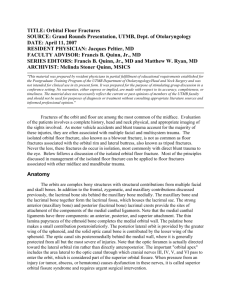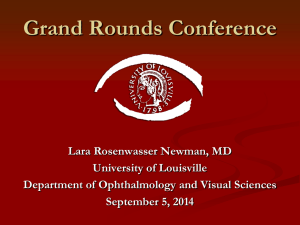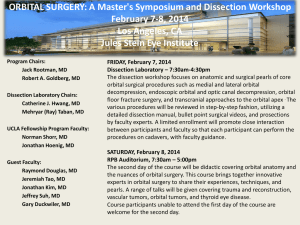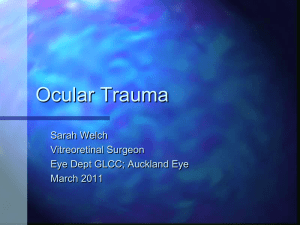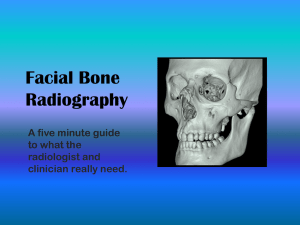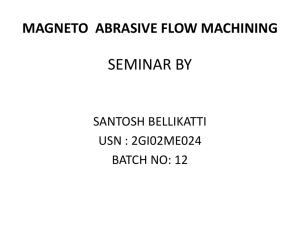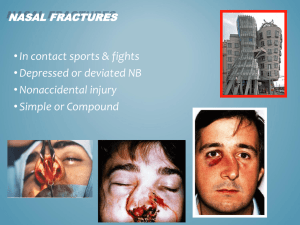view poster
advertisement
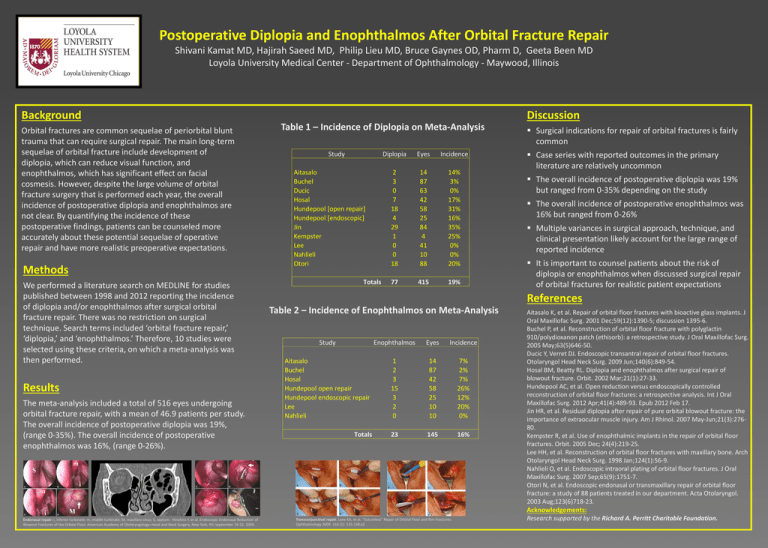
Postoperative Diplopia and Enophthalmos After Orbital Fracture Repair Shivani Kamat MD, Hajirah Saeed MD, Philip Lieu MD, Bruce Gaynes OD, Pharm D, Geeta Been MD Loyola University Medical Center - Department of Ophthalmology - Maywood, Illinois Background Orbital fractures are common sequelae of periorbital blunt trauma that can require surgical repair. The main long-term sequelae of orbital fracture include development of diplopia, which can reduce visual function, and enophthalmos, which has significant effect on facial cosmesis. However, despite the large volume of orbital fracture surgery that is performed each year, the overall incidence of postoperative diplopia and enophthalmos are not clear. By quantifying the incidence of these postoperative findings, patients can be counseled more accurately about these potential sequelae of operative repair and have more realistic preoperative expectations. Methods We performed a literature search on MEDLINE for studies published between 1998 and 2012 reporting the incidence of diplopia and/or enophthalmos after surgical orbital fracture repair. There was no restriction on surgical technique. Search terms included ‘orbital fracture repair,’ ‘diplopia,’ and ‘enophthalmos.’ Therefore, 10 studies were selected using these criteria, on which a meta-analysis was then performed. Results The meta-analysis included a total of 516 eyes undergoing orbital fracture repair, with a mean of 46.9 patients per study. The overall incidence of postoperative diplopia was 19%, (range 0-35%). The overall incidence of postoperative enophthalmos was 16%, (range 0-26%). Endonasal repair: i, inferior turbinate; m, middle turbinate; M, maxillary sinus; S, septum. Hinohira Y, et al. Endoscopic Endonasal Reduction of Blowout Fractures of the Orbital Floor. American Academy of Otolaryngology–Head and Neck Surgery, New York, NY, September 19-22, 2004. Discussion Table 1 – Incidence of Diplopia on Meta-Analysis Study Aitasalo Buchel Ducic Hosal Hundepool [open repair] Hundepool [endoscopic] Jin Kempster Lee Nahlieli Otori Totals Diplopia Eyes Incidence 2 3 0 7 18 4 29 1 0 0 18 14 87 63 42 58 25 84 4 41 10 88 14% 3% 0% 17% 31% 16% 35% 25% 0% 0% 20% 77 415 19% Surgical indications for repair of orbital fractures is fairly common Case series with reported outcomes in the primary literature are relatively uncommon The overall incidence of postoperative diplopia was 19% but ranged from 0-35% depending on the study The overall incidence of postoperative enophthalmos was 16% but ranged from 0-26% Multiple variances in surgical approach, technique, and clinical presentation likely account for the large range of reported incidence It is important to counsel patients about the risk of diplopia or enophthalmos when discussed surgical repair of orbital fractures for realistic patient expectations References Table 2 – Incidence of Enophthalmos on Meta-Analysis Study Enophthalmos Eyes Incidence Aitasalo Buchel Hosal Hundepool open repair Hundepool endoscopic repair Lee Nahlieli 1 2 3 15 3 2 0 14 87 42 58 25 10 10 7% 2% 7% 26% 12% 20% 0% 23 145 16% Totals Transconjunctival repair. Lane KA, et al. “Sutureless” Repair of Orbital Floor and Rim Fractures. Ophthalmology 2009. 116 (1): 135-138.e2 Aitasalo K, et al. Repair of orbital floor fractures with bioactive glass implants. J Oral Maxillofac Surg. 2001 Dec;59(12):1390-5; discussion 1395-6. Buchel P, et al. Reconstruction of orbital floor fracture with polyglactin 910/polydioxanon patch (ethisorb): a retrospective study. J Oral Maxillofac Surg. 2005 May;63(5)646-50. Ducic Y, Verret DJ. Endoscopic transantral repair of orbital floor fractures. Otolaryngol Head Neck Surg. 2009 Jun;140(6):849-54. Hosal BM, Beatty RL. Diplopia and enophthalmos after surgical repair of blowout fracture. Orbit. 2002 Mar;21(1):27-33. Hundepool AC, et al. Open reduction versus endoscopically controlled reconstruction of orbital floor fractures: a retrospective analysis. Int J Oral Maxillofac Surg. 2012 Apr;41(4):489-93. Epub 2012 Feb 17. Jin HR, et al. Residual diplopia after repair of pure orbital blowout fracture: the importance of extraocular muscle injury. Am J Rhinol. 2007 May-Jun;21(3):27680. Kempster R, et al. Use of enophthalmic implants in the repair of orbital floor fractures. Orbit. 2005 Dec; 24(4):219-25. Lee HH, et al. Reconstruction of orbital floor fractures with maxillary bone. Arch Otolaryngol Head Neck Surg. 1998 Jan;124(1):56-9. Nahlieli O, et al. Endoscopic intraoral plating of orbital floor fractures. J Oral Maxillofac Surg. 2007 Sep;65(9):1751-7. Otori N, et al. Endoscopic endonasal or transmaxillary repair of orbital floor fracture: a study of 88 patients treated in our department. Acta Otolaryngol. 2003 Aug;123(6)718-23. Acknowledgements: Research supported by the Richard A. Perritt Charitable Foundation.
